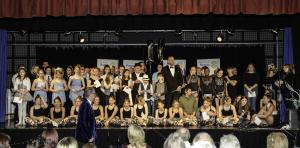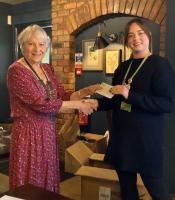Intro to PAs in Notts and Derbys
Thu, Jun 19th 2025 at 7:01 pm - 9:01 pm
Meghan King Presents
Club members please log in for more information.
Thursday 18th. June 2025, ‘An Introduction to the PAS in Derbyshire and Nottinghamshire’ - Meghan King
Meghan first asked the rhetoric question – How did I get here? – and answered: University – BA and an MA in Archaeology, Volunteering – to “Jorvik”, and to the Derby Museums, etc.
What is my role? This included: ‘Daily tasks’ including – Recording finds, photographing and editing, enquiries, the management of volunteers. ‘The Treasure process’ – Requires progression as a Legal process. Outreach – Talks, club meetings, YAC, Finds Days; Newark, Retford, Nottingham, Chesterfield, Buxton
What is PAS? It is the Portable Antiquities Scheme:
The Portable Antiquities Scheme (PAS) is an organisation run by the British Museum and The National Museum Wales; it is designed to encourage the recording of archaeological objects found by members of the public. Those objects of particular interest may provide a reward of a 50/50 share.
This scheme plays a critical role in advancing knowledge, telling stories of past communities and furthering public interest in the past.
An example was shown of: DENO-00FD99 (2017T1133) – A Medieval gold finger ring from Alfreton.
Meghan proceeded with explanation of ‘The 1996 Treasure Act’: For a specific ‘find’ such as the LEIC-CF1664 (2020T936) – Consisting of a Medieval Silver Coin hoard from Longford (acquired by DMAG).
For metallic objects generally, other than for coins, and provided that they are at least 10 per cent by weight of metal, then they are precious metals (that is, gold or silver), and they are at least 300 years old.
Changes to the Treasure Act From 30th July 2023, the Treasure Act was amended to include any metallic object which is older than 200 years and is deemed ‘significant’.
An object will satisfy this significance criteria if it provides an exceptional insight into an aspect of national or regional history, archaeology, or culture based on one or more of the following factors:
– It is a rare example of its type.
–
The location in which it was found is significant.
– It has a connection with a particular person or event.
The Treasure Act Code of Practice was also updated to provide clearer guidance on the process for all parties, therefore if you would like more information on the treasure process and the definition of treasure please visit: https://finds.org.uk/treasure.
Meghan Progressed with interesting finds recorded by DENO, typically by reduction in age, as follows:
The PALAEOLITHIC 800,000 – 10,000 BC age. – Palaeolithic curved backed blades from Whitwell.
MESOLITHIC 10,000 – 4000 BC age – A Mesolithic flint scraper from Litton
NEOLITHIC 4,000 – 2,350 BC – Neolithic polished stone axehead from Catton
BRONZE AGE 2,350 – 800 BC – Flint barbed and tanged arrowhead from Wirksworth
DATING FROM c. 950 to 800 BC. – DENO-88980E – A Bronze Age hoard comprising of 13 objects. Important and rare objects types within the hoard. Socketed chisel, socketed hammer and axe mould. The Treasure case acquired by Weston Park Museum, comes under 2003 Treasure definition.
DATING FROM c. 2200 to 800 BC. DENO-1E3DC5 – Bronze Age gold ribbon Seeing more reported, possibly due to an increase in awareness of the object type and age. If found, we would encourage people not to unroll or unfold. A Treasure case acquired by Derby Museums, comes under 1997 Treasure definition.
ADDITIONAL ITEMS SHOWN INCLUDED THE FOLLOWING:
DENO-765295 – Iron Age copper alloy harness fitting from Buxton
DENO-765295 – Late Iron Age to early Roman copper alloy harness fitting or strap slide dating from c. 50 BC to AD 200. Importance of showing finds to FLO, finder thought this find was modern.
DENO-77BCF5 – Iron Age uninscribed Lindsey Scyphate quarter stater dating from c. 50 to 20 BC. Obverse. These are relatively rare finds, with around 54 examples recorded on the PAS database. The distribution focuses on Lincolnshire and surrounding counties. The Derbyshire area did not produce its own coinage in the Iron Age
DENO-651C91 and DENO-64DAE1 (2007T709) – Roman gold aurei of Carausius from Ashbourne (acquired by The British Museum and DMAG).
DENO-F46FB5 - Early medieval gold circular stud, mount or possible pendant with a domed garnet setting dating from c. AD 580 to 650.
More early medieval finds similar to this one being recorded is adding to the knowledge of gold working during this period, such as the plaited wire and annulet designs. Treasure case acquired by The National Civil War Centre, comes under 1997 Treasure definition.
and last, but not least – a Roman sock.
Meghan concluded with a map of the finds around the area.
Meghan closed the presentation with the following:
Thank you for listening, if you have any questions, I am more than happy to answer them.
meghan@derbymuseums.org www.finds.org.uk
The interest shown by the Club Members in the items exhibited after the presentation was immense.
AW
'What We Do' Main Pages:

We have now successfully run this event for 10 years. Full reports of each year are available under this main page
more
It's here that you can read what we've been up to in the last few months. For more information on our work in the local community, with our young people and internationally please access "what we do" section of this web site.
more
This is a monthly meeting open to visitors from Bingham, Radcliffe, Cotgrave and all villages in surrounding area.
moreThis committee are involved in planning now we can raise funds for our chosen charities
moreIf you like what we do as an organisation and are interested in volunteering with us, keeping up to date with our plans and future events then why not consider signing up as a friend of our Rotary Club
moreOur International Committee is involved with Polio Plus - a Rotary initiative to eradicate Polio, World-wide; Sand dams; Aqua Boxes; Shelter Boxes; Collecting used spectacles, and many other projects
moreHere you can read about the many meetings we've had during our formation as a Rotary Club. The early years are a little short on detail...
more
